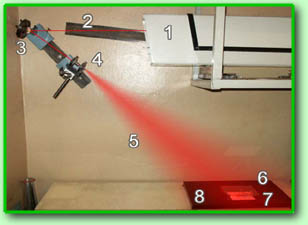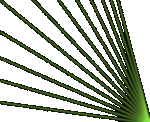|
1. Scheme of
Denisyuk's hologram recording
 So, we begin
the practical course on holography. The first lessons
will be devoted to studying Denisyuk's scheme. It
is no wonder, Denisyuk's scheme is the simplest
holographic scheme, you know. However, it's possible
to record holograms of the highest quality using
that scheme. So, we begin
the practical course on holography. The first lessons
will be devoted to studying Denisyuk's scheme. It
is no wonder, Denisyuk's scheme is the simplest
holographic scheme, you know. However, it's possible
to record holograms of the highest quality using
that scheme.
The
scheme got its name from the famous Russian scientist
- Yury Nikolaevich Denisyuk,
who invented the procedure of reflection hologram
recording on transparent photographic plates in
the beginning of the seventies. Before that holograms
were recorded according to Leith-Upatnieks
method and a laser was necessary for their observing.
Denisyuk proposed to expose the plate and the object
with the same laser beam to see holograms in the
usual white light. It was necessary to develop special
photo plates, which had to be transparent and have
very high resolution. The problem was successfully
solved.
First
figure shows a scheme of Denisyuk's hologram recording
and the second one demonstrates a photo of a real
setup. Narrow light beam 2 from the laser
1 is directed by the mirror 3 to spatial
filter 4,  which expands the beam up
to the necessary size and simultaneously improves
its homogeneity. Expanded beam 5 exposes
photoplate 6 and the object 7, which
is fixed on a rigid base 8. Laser light is
reflected from the object to the photoplate from
the reverse side. Two beams meet each other in the
photoplate's plane: the first beam goes from the
laser and it is called a "reference beam"
and the second one, which goes from the object,
is called a "signal beam". These beams
create an interference pattern,
which is registered on the photo plate. An interference
pattern represents the smallest differences of a
light intensity with the period less than 1micron.
A complete immobility of the object and the photo
plate during exposing is necessary to register such
a fine pattern. Therefore soft objects and living
objects, for instance, animals, cannot be recorded
in the scheme with the continuous-wave laser. which expands the beam up
to the necessary size and simultaneously improves
its homogeneity. Expanded beam 5 exposes
photoplate 6 and the object 7, which
is fixed on a rigid base 8. Laser light is
reflected from the object to the photoplate from
the reverse side. Two beams meet each other in the
photoplate's plane: the first beam goes from the
laser and it is called a "reference beam"
and the second one, which goes from the object,
is called a "signal beam". These beams
create an interference pattern,
which is registered on the photo plate. An interference
pattern represents the smallest differences of a
light intensity with the period less than 1micron.
A complete immobility of the object and the photo
plate during exposing is necessary to register such
a fine pattern. Therefore soft objects and living
objects, for instance, animals, cannot be recorded
in the scheme with the continuous-wave laser.
References
1. Leith E. N., Upatnieks J. Journ. Opt. Soc. Amer.,
v. 54, 1295, 1964.
2. Denisyuk Y. N. Optika i Spektroskopiya, v. 15,
522, 1963.
3. Fyodorov B. F., Cibulkin L. M. Golographiya.
Moscow, Radio I Svyaz, 1989.
-->
|





